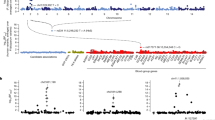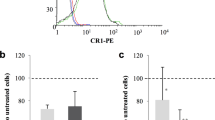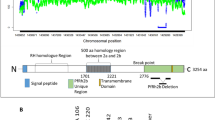Abstract
Complement receptor-1 (CR1) is a ligand for rosette formation, a phenomenon associated with cerebral malaria (CM). Binding is dependent on erythrocyte CR1 copy number. In Caucasians, low CR1 expressors have two linked mutations. We determined the Q981H and HindIII RFLP distribution in differing population groups to ascertain a possible role in adaptive evolution. We examined 194 Caucasians, 180 Choctaw Indians, 93 Chinese-Taiwanese, 304 Cambodians, 89 Papua New Guineans (PNG) and 366 Africans. PCR/RFLP used HindIII for CR1 expression and BstNI for the Q981H mutation. DNA sequencing and pyrosequencing were performed to resolve inconclusive results. Gene frequencies for the L allele were 0.15 in Africans, 0.16 in Choctaws, 0.18 in Caucasians, 0.29 in Chinese-Taiwanese, 0.47 in Cambodians and 0.58 in PNG. Allelic frequency for 981H were 0.07 in Africans, 0.15 in Caucasians, 0.18 in Choctaws, 0.29 in Chinese-Taiwanese, 0.47 in Cambodians and 0.54 in PNG. The Q981H polymorphism correlates with the HindIII RFLP in most groups except West Africans and appears to be part of a low CR1 expression haplotype. The gene frequency for the haplotype is highest in the malaria-endemic areas of Asia, suggesting that this haplotype may have evolved because it protects from rosetting and CM.
This is a preview of subscription content, access via your institution
Access options
Subscribe to this journal
Receive 6 digital issues and online access to articles
$119.00 per year
only $19.83 per issue
Buy this article
- Purchase on Springer Link
- Instant access to full article PDF
Prices may be subject to local taxes which are calculated during checkout




Similar content being viewed by others
References
Breman JG . The ears of the hippopotamus: manifestations, determinants and estimates of the malaria burden. Am J Trop Med Hyg 2001; 64 (Suppl 1–2): 1–11.
Breman JG, Egan A, Keusch GT . The intolerable burden of malaria: a new look at the numbers. Am J Trop Med Hyg 2001; 64 (Suppl 1–2): iv–vii.
Ridley RG . Medical need, scientific opportunity and the drive for antimalarial drugs. Nature 2002; 415: 686–693.
Chauhan VS, Bhardwaj D . Current status of malaria vaccine development. Adv Biochem Eng Biotechnol 2003; 84: 143–182.
Bozdech Z, Llinas M, Pulliam BL, Wong ED, Zhu J, DeRisi JL . The transcriptome of the intraerythrocytic developmental cycle of Plasmodium falciparum. PLoS Biol 2003; 1: E5 Epub 2003 August 18.
Krych-Goldberg M, Moulds JM, Atkinson JP . Human complement receptor type 1 (CR1) binds to a major malarial adhesion. Trends Mol Med 2002; 8: 531–537.
Rowe JA, Moulds JM, Newbold CI, Miller LH . P. falciparum rosetting mediated by a parasite-variant erythrocyte membrane protein and complement-receptor 1. Nature 1987; 388: 292–295.
Rowe JA, Rogerson SJ, Raza A et al. Mapping of the region of complement receptor (CR) 1 required for Plasmodium falciparum rosetting and demonstration of the importance of CR1 in rosetting in field isolates. J Immunol 2000; 165: 6341–6346.
Pasvol G . Cell–cell interaction in the pathogenesis of severe falciparum malaria. Clin Med 2001; 1: 495–500.
Smith JD, Gamain B, Baruch DI, Kyes S . Decoding the language of var genes and Plasmodium falciparum sequestration. Trends Parasitol 2001; 17: 538–545.
Fernandez V, Wahlgren M . Rosetting and autoagglutination in Plasmodium falciparum. Chem Immunol 2002; 80: 163–187.
Chen Q, Barragan A, Fernandez V et al. Identification of Plasmodium falciparum erythrocyte membrane protein 1 (PfEMP1) as the rosetting ligand of the malaria parasite P.falciparum. J Exp Med 1998; 187: 15–23.
Moulds JM, Kassambara L, Middleton JJ et al. Identification of complement receptor one (CR1) polymorphisms in West Africa. Genes Immun 2000; 1: 325–329.
Klickstein LB, Wong WW, Smith JA, Weis JH, Wilson JG, Fearon DT . Human C3b/C4b receptor (CR1). Demonstration of long homologous repeating domains that are composed of the short consensus repeats characteristics of C3/C4 binding proteins. J Exp Med 1987; 165: 1095–1112.
Hourcade D, Miesner DR, Atkinson JP, Holers VM . Identification of an alternative polyadenylation site in the human C3b/C4b receptor (complement receptor type 1) transcriptional unit and prediction of a secreted form of complement receptor type 1. J Exp Med 1988; 168: 1255–1270.
Klickstein LB, Barbashov S, Liu T, Jack RM, Nicholson-Weller A . Complement receptor type one (CR1, CD35) is a receptor for C1q. Immunity 1997; 7: 345–349.
Ghiran I, Barbashov SF, Klickstein LB, Tas SW, Jensenius JC, Nicholson-Weller A . Complement receptor1/CD35 is a receptor for mannan-binding lectin. J Exp Med 2000; 192: 1797–1807.
Cornillet P, Philbert F, Kazatchkine MD, Cohen JHM . Genomic determination of the CR1 (CD35) density polymorphism on erythrocytes using polymerase chain reaction amplification and HindIII restriction enzyme digestion. J Immunol Meth 1991; 136: 193–197.
Herrera AH, Xiang L, Martin SG, Lewis J, Wilson JG . Analysis of complement receptor type 1 (CR1) expression on erythrocytes and of CR1 allelic markers in Caucasian and African American populations. Clin Immunol Immunopathol 1998; 87: 176–183.
Xiang L, Rundles JR, Hamilton DR, Wilson JG . Quantitative alleles of CR1: coding sequence analysis and comparison of haplotypes in two ethnic groups. J Immunol 1999; 163: 4939–4945.
Birmingham DJ, Chen W, Liang G, Schmitt C, Gavit K, Nagaraja HN . A CR1 polymorphism associated with constitutive erythrocyte CR1 levels affects binding to C4b but not C3b. Immunology 2003; 108: 531–538.
Rowe A, Obeiro J, Newbold CI, Marsh K . Plasmodium falciparum rosetting is associated with malaria severity in Kenya. Infect Immun 1995; 63: 2323–2326.
Cockburn IA, Mackinnon MJ, O'Donnell A et al. A human complement receptor one polymorphism that reduces Plasmodium falciparum rosetting confers protection against severe malaria. Proc Natl Acad Sci USA 2004; 101: 272–277.
Moulds JM, Zimmerman PA, Doumbo OK et al. Molecular identification of Knops blood group polymorphisms found in long homologous region D of complement receptor 1. Blood 2001; 97: 2879–2885.
Gibbons A . Tools show humans reach Asia early. Science 2001; 293: 2368–2369.
Zimmer C . Genetic trees reveal disease origins. Science 2001; 292: 1090–1093.
Gibbons A . Peopling of the Pacific. Science 2001; 291: 1735–1737.
Miller LH . Impact of malaria on genetic polymorphisms and genetic diseases in Africans and African-Americans. Proc Natl Acad Sci USA 1994; 91: 2415–2419.
Acknowledgements
We thank Sue Riester of Somerset Laboratories, New York; Gwan Wu of the Shen Zhen Blood Center, Peoples Republic of China; Marie Lin of the Mackay Memorial Hospital, Taiwan; Frank Arnett and John Reveille of the University of Texas Medical School, Houston for providing materials from USA-Caucasians, Chinese, Taiwanese and Choctaw Indians, respectively. We are grateful to Chris Plowe of the University of Maryland Medical School, Ogobara Doumbo and Dapa Diallo of the University of Bamako who facilitated material collection from Mali. This project has been funded in part with Federal funds from the National Institute of Allergy and Infectious Diseases, National Institutes of Health grant RO1-AI-42367 (JMM) and Contract No. N01-AI-85346 (CVP). Additional funding was provided by the Somerset Laboratories, New York (JMM).
Author information
Authors and Affiliations
Corresponding author
Rights and permissions
About this article
Cite this article
Thomas, B., Donvito, B., Cockburn, I. et al. A complement receptor-1 polymorphism with high frequency in malaria endemic regions of Asia but not Africa. Genes Immun 6, 31–36 (2005). https://doi.org/10.1038/sj.gene.6364150
Received:
Revised:
Accepted:
Published:
Issue Date:
DOI: https://doi.org/10.1038/sj.gene.6364150
Keywords
This article is cited by
-
A novel mouse model expressing human forms for complement receptors CR1 and CR2
BMC Genetics (2020)
-
Red cell polymorphisms and malaria: an evolutionary approach
Bulletins et mémoires de la Société d'anthropologie de Paris (2013)



